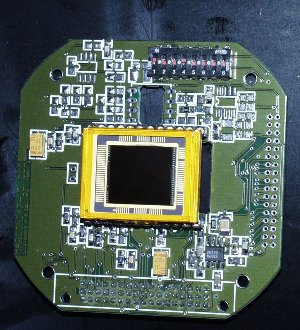
Marconi47-10 clamped to its head PCB, note the CCD sensitive area is really dark !!
New : Tests on the sky with the Marconi47-10 (Feb 2002)
This page aims at comparing two high performance CCD devices that can be used for Imaging/Spectroscopy in Astronomy : The Marconi47-10 and the Kaf1602E (This page was written in 2002).
The following table has been compiled to compare the two devices in a nutshell.
|
Marconi 47-10
|
Kaf1602E
|
|
| Pixels |
1024x1024
|
1536x1024
|
| Sensitive area (mm) |
13.3x13.3
|
13.8x9.2
|
| Pixel size (um) |
13
|
9
|
| Backside Illuminated |
Yes
|
No
|
| Peak Signal (Ke-) |
100
|
85
|
| Dark Current MPP (pA/cm2 at 25°C) |
31
|
4
|
| Dark Current MPP (e-/pix/sec at 25°C) |
330
|
20
|
| Read Noise |
2e- at 20kpx/sec
|
15e- at 50kpx/sec
|
| Package |
Ceramic Dil
|
Ceramic Dil
|
| Convertion Factor (mv/e-) |
3.7
|
10
|
| Maximum readout frequency (Mpx/sec) |
5
|
10-15
|
| Price |

Marconi47-10 clamped to its head PCB, note the CCD sensitive area is really
dark !!
Dark current is an important issue concerning for non Liquid Nitrogen cooled
camera (or cooled with thermo-peltier elements).
This will now going to be evaluated in the next section.
If the technology of manufacturing the CCDs would be the same for Kodak and Marconi, the dark current ratio would only be 2.2 because of the square of the difference of pixels size between the two CCDs. Thus, meaning that we need also to compare the two device by scaling the kaf1602 pixels size by a factor of 2.2.
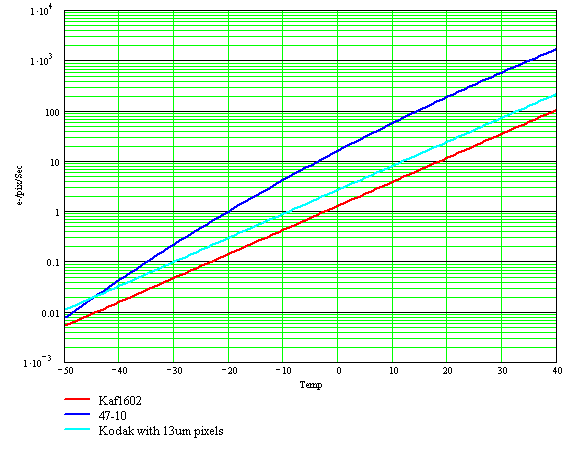
Dark current in e-/pix/sec for the 47-10, the Kaf1602 and the virtual Kaf1602
with 13um pixels
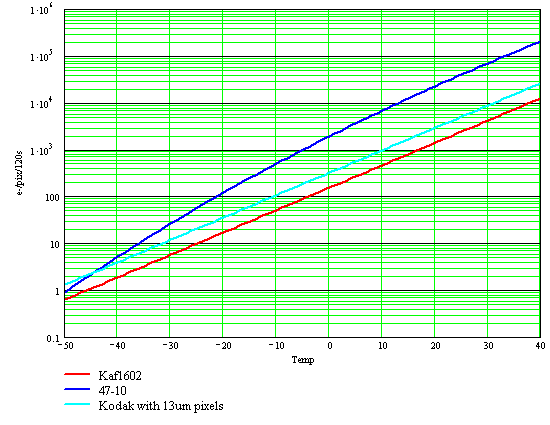
Dark current in e-/pix from 120 sec exposure, for the 47-10, the Kaf1602
and the virtual Kaf1602 with 13um pixels

Noise contribution of the Dark current in e- from a 120sec exposure, for
the 47-10, the Kaf1602 and the virtual Kaf1602 with 13um pixels
The next table shows dark current for a 120 sec exposure (electrons per pixels).
"Noise" stands for additionnal noise brought by the dark current,
in that case the total noise is :
Noisetotal^2 = (readoutNoise^2 + DarkNoise^2)
| Temperature |
Marconi 47-10
|
Kaf1602E
|
||
|
(°C)
|
Noise (e-)
|
Value
|
Noise (e-)
|
Value
|
|
-50
|
0.9
|
0.9
|
0.79
|
0.62
|
|
-40
|
2.25
|
5.1
|
1.37
|
1.88
|
|
-30
|
5.1
|
26
|
2.4
|
5.6
|
|
-25
|
7.5
|
56
|
3.1
|
9.8
|
|
-20
|
11
|
120
|
4.1
|
17
|
|
-15
|
15.7
|
247
|
5.42
|
30
|
|
-10
|
22
|
501
|
7.1
|
51
|
|
-5
|
31.4
|
990
|
9.4
|
88.5
|
|
0
|
44
|
1920
|
12.4
|
153
|
|
10
|
82
|
6804
|
21.4
|
460
|
|
25
|
199
|
39760
|
50
|
2400
|
If the readout electronics of the camera provides 10e- noise, an increase of 1.414 (square root of 2) would happen at -5°C for the Kaf1602 and at -20°C for the Marconi47-10. The dark current of the kaf1602 is really impressivly low .... certainly the best in the market.
but, do we need to expose 120sec with the two CCD to get the same result ?
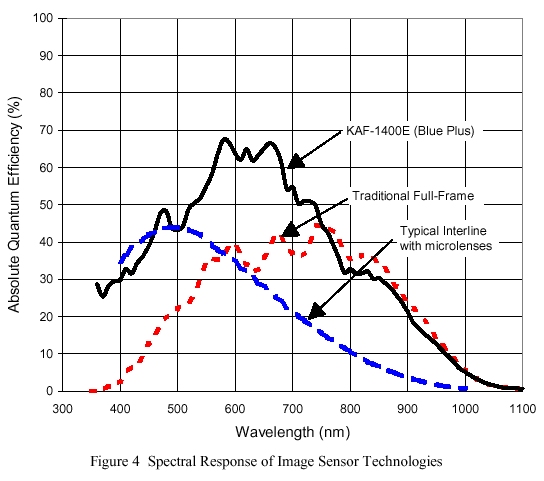
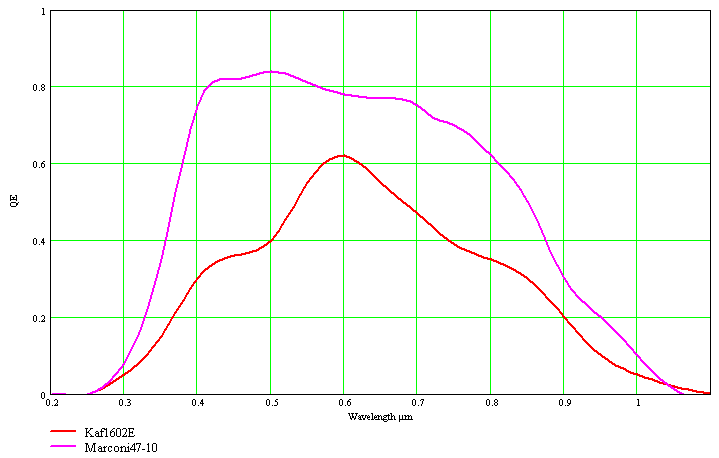
QE of the two devices (marconi47-10 is more sensitive !)
If one compare the overall sensivity gain using the Marconi47-10 device with the Kaf1602E, we have (integrating QE curves):
In the B band, one can expose 2.4 time less !
To compare directly the two devices on the sky; one should for instance take a focal length of "L" for the Marconi47-10 and use a focal length of 0.69*L with the Kaf1602E in order to get the same sky background sampling. This is at some point something that could be worth to be done.
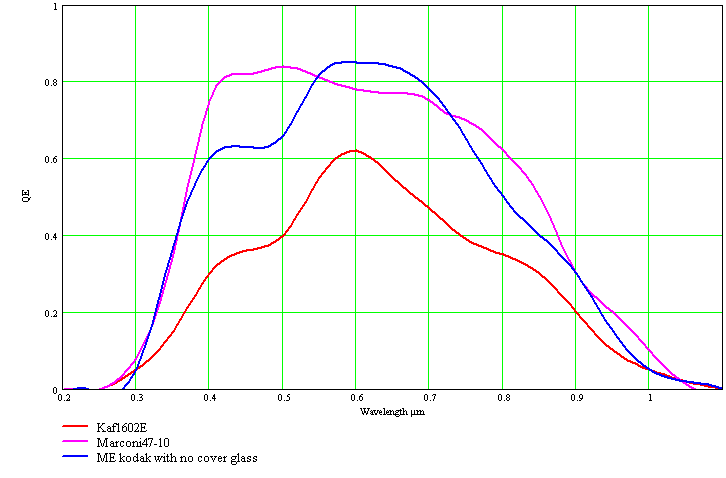
NEW
!! Quantum efficiency comparison, with the new ME technology (CCD with
no glass cover)
I could procure a Marconi47-10 sample (8432-20-3) Grade 5, I'd like to thank
Paul Jordan from Marconi to have provided me with this chip.
This is a 371 device, meanning this device it has a broadband coating for a
better QE in the range of 350-700nm. This device has no cosmetic defects,
but rated as a grade 5 device because it did not fullfill the following
parameters :
Here is Marconi test report for this 8432-20-3 device
These problems does not really geopardize the device performance, even if it is a grade 5 device, it is still usable !
Dark current is an important issue, I used our homemade Chungara controller to test this device, and I could achieve 9e- noise at 85Kpx/sec.
Window of a bias frame, with 9e- noise
Also a 10 median stacked frames of a 120sec dark frame each (CCD temperature was -45°C) the outside air temperature was -15°C:
This frame has a mean dark current of 8e- : so additionnal noise is 2.8e-, and overall noise from 9e- (bias) to 9.5e-. Also, dark signal is not really uniform, the mean is 8e-, but can be tripled in some areas. To be confirmed if all devices are afected by this dark signal non uniformity.
Also 154 hot pixels can be noticed, the distribution of the hot pixels is close
to the bias and their effects is really limited. Their amount is negligible.

By changing the image phase voltages, A drastic decrease of dark current has been noticed !! At -30°C only, I could get 3.7ADU of dark current using a 60s exposure, yielding to 7.4e-. This is what I could get at -45°C. Also the dark uniformity is very good, no large scale pattern is visible.

1000x200 area pixels sub-image.
The image histogram showed no increase of hot pixels, 100% of pixels have intensity less than 800e-.

To compare with Kaf1602E CCD, a 120 sec exposure at -?°C shows large amount
of bright pixels (26400 pixels are hot, 1.7% off all the pixels)
There is three population of hot pixels as plotted in the following histogram
: Population 1 and 2 close the bias level and various hots pixels form population
3 that have a non linear behavior and really hard to cancel out.
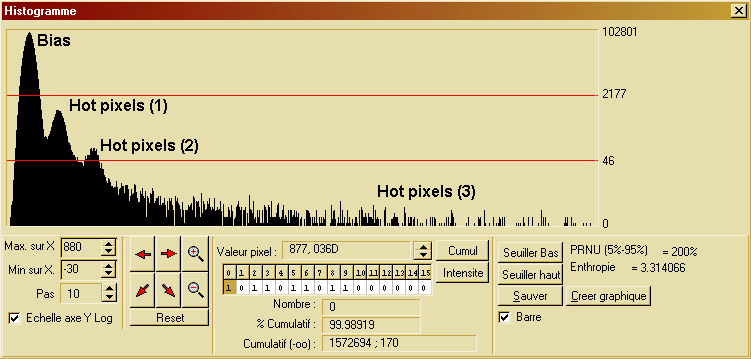

Typical dark 120sec exposure with Kaf1602E
Tests on the sky with the Marconi47-10
Thinned devices hexibits fringing pattern at wavelength more than 700nm, because
the silicon becomes transparent at that wavelength.
The next image is a median stack of 10 Flat fields, recorded thru a R broadband
filter.
This the cross section plot of the previous image, expressed in raw ADUs. Peak to Peak is 500 adus.
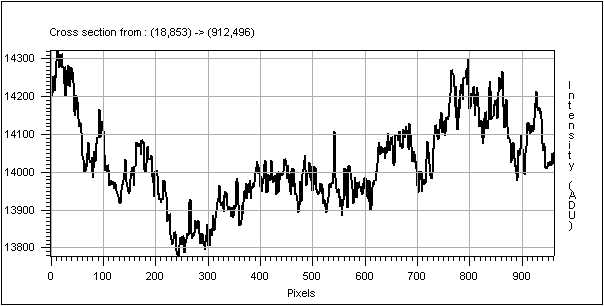
This can be substracted by making a super sky night flat field.
This is an email from Marconi (Paul Jordan) about 47-10 pricing :1 UKP is 1.61 Euros, or 10.57 French francs
You ask for 'std package'. Just to be clear I should say that the sample 47-10-5-371 package, which we call 'compact' is now the preferred one for sale. [The previous standard package was the larger ceramic one].
Here are some prices-
1-9 off 47-10-0-371 (gr-0) 3800 UKP each.
1-9 off 47-10-1-371 (gr-1) 2900 UKP each.
1-9 off 47-10-2-371 (gr-2) 2300 UKP each.
These chips are AIMO, with 'standard' broadband coating.
We also do the -353 device with 'standard' midband coating, which has somewhat better midband response. This device is the same price as the -371.
If you want better UV/blue response then you would want the -352 device
which has the 'astronomy' broadband process. These prices are-
1-9 off 47-10-0-352 (gr-0) 5700 UKP each.
1-9 off 47-10-1-352 (gr-1) 4400 UKP each.
1-9 off 47-10-2-352 (gr-2) 3500 UKP each.
The delivery time is 16 wks for the -352 device, and 12 weeks for the first
ones, at present.
I think that using grade 4 or 5 would be satisfactory for deep sky imaging.....
Price to be asked to Paul.
Engineering grade costs 460Eur, but this one is sold if a standard device is bought togehter. Some of the engineering grade, despite their low cost, can hexibit lethal problems, like bias stability. A class 1 CCD costs 4500 Euros.
Other price to be asked to R.David.